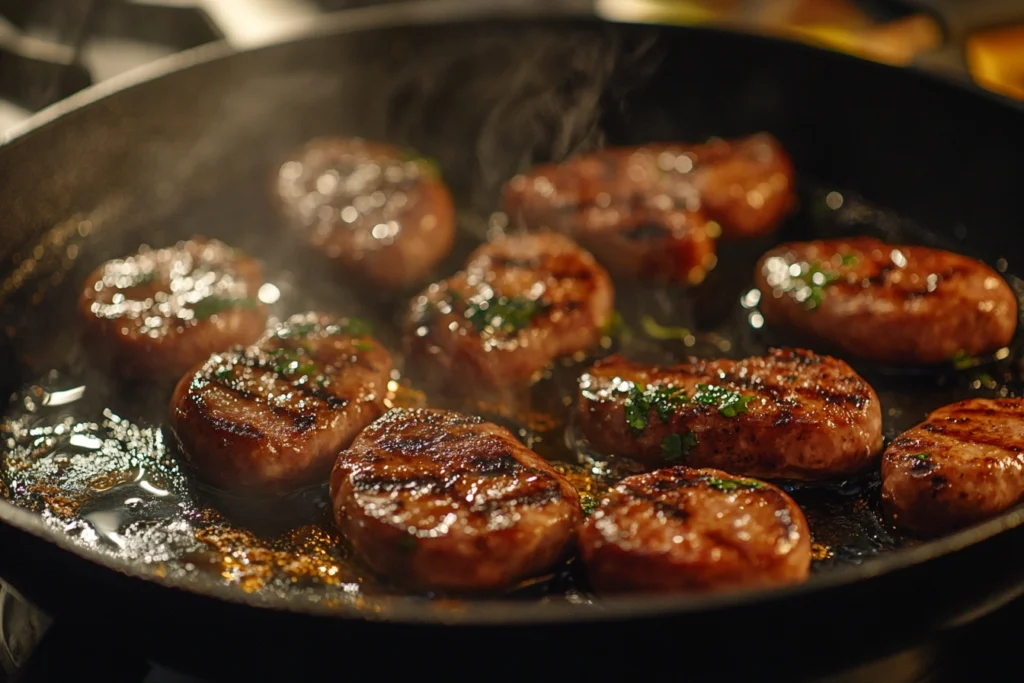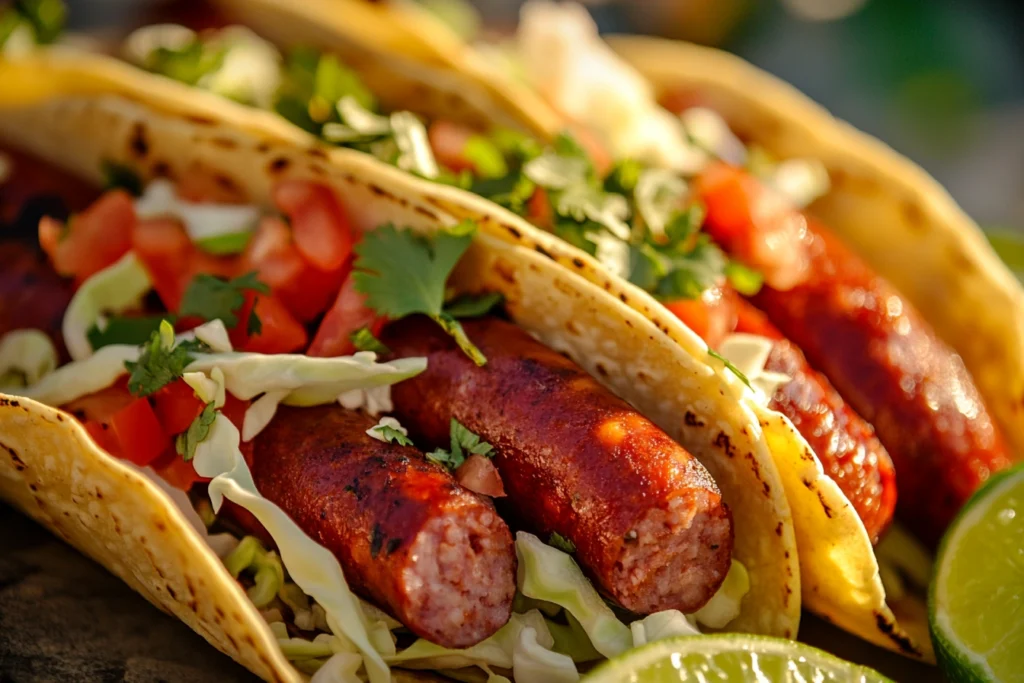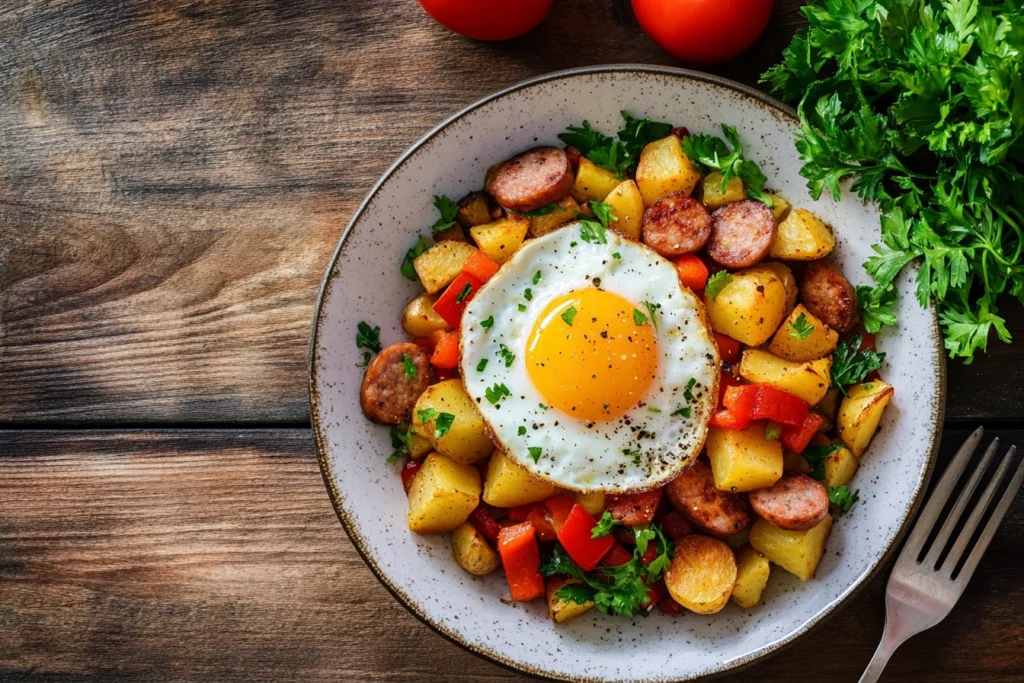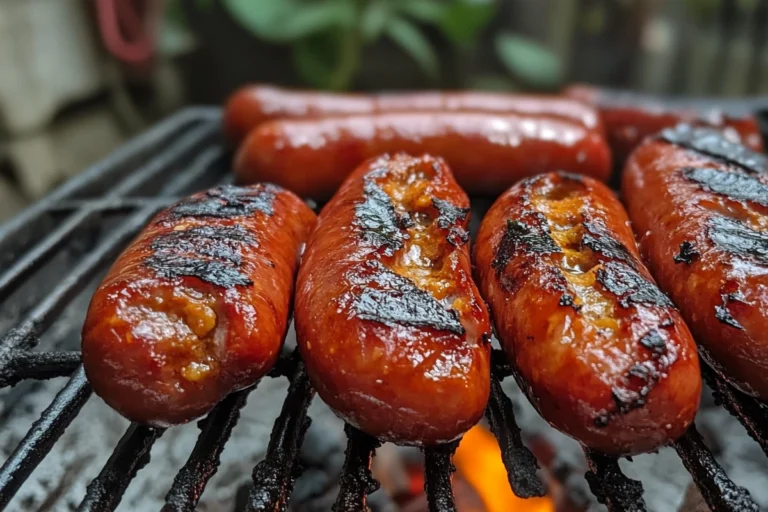Introduction
Red hot sausages are more than just a spicy treat—they’re a culinary staple packed with bold flavors, vibrant colors, and mouthwatering heat. Whether you’re firing up the grill for a weekend BBQ, whipping up a quick weeknight dinner, or looking for a zesty addition to your favorite dish, red hot sausages deliver a satisfying punch. In this guide, we’ll dive deep into what makes these sausages so irresistible, from their origins and types to cooking techniques, health tips, and even creative leftover ideas. Get ready to explore everything you need to know about red hot sausages!
Looking for inspiration? Try our Chicken Cheesesteak Recipe for another bold, flavorful dish.
What Are Red Hot Sausages?
The History of Red Hot Sausages
Red hot sausages have roots that stretch across various cultures, particularly in the American South, where bold flavors reign supreme. Their origins are tied to traditional sausage-making techniques brought over by European immigrants, especially from Germany and Poland. Over time, these sausages were adapted to suit local tastes, with a heavier emphasis on heat and spice. The distinctive bright red color and fiery kick became iconic, representing the bold spirit of Southern cuisine.
In regions like Louisiana and Texas, red hot sausages evolved alongside Cajun and Creole cooking traditions, often seasoned with a mix of paprika, cayenne pepper, garlic, and other spices. Today, they’re enjoyed worldwide, with each region adding its own twist to the classic recipe.
Key Ingredients That Make Them Spicy and Flavorful
The secret to the bold taste of red hot sausages lies in their ingredients. While the exact recipe can vary, most red hot sausages include a combination of:
- Meat: Typically pork, beef, or a mix of both. Some variations also include chicken or turkey for a leaner option.
- Fat: Essential for moisture and flavor, ensuring the sausage stays juicy during cooking.
- Spices: Cayenne pepper, crushed red pepper flakes, paprika, black pepper, and garlic powder create the signature heat and depth of flavor.
- Salt: Enhances the other flavors and helps preserve the sausage.
- Natural or Artificial Coloring: The bright red hue often comes from paprika, annatto, or food coloring, which gives the sausages their distinctive look.
- Binders and Fillers: Some commercial sausages use breadcrumbs or rusk to improve texture, though traditional recipes rely solely on meat and spices.
This combination of spices, quality meat, and vibrant color is what makes red hot sausages a standout in the world of savory treats.
Types of Red Hot Sausages You Need to Try
Regional Variations of Red Hot Sausages
Red hot sausages come in many varieties, influenced by regional tastes and culinary traditions. Each version offers a unique twist on the classic spicy sausage, from the bold flavors of the American South to international adaptations.
- Southern Red Hots: A staple in states like Louisiana, Mississippi, and Alabama, these sausages are known for their intense heat, thanks to generous amounts of cayenne pepper and paprika. They’re often enjoyed grilled or smoked, with a crisp outer casing and juicy interior.
- Carolina Red Hots: In North Carolina, red hot sausages are typically served with slaw and mustard on a bun, resembling a spicy hot dog. They’re popular at BBQ joints and roadside stands.
- Texas Hot Links: These sausages are spicier and smokier, with a coarser texture. Commonly made from beef, they feature bold spices like chili powder, garlic, and black pepper, perfect for grilling or smoking.
- International Variations: In places like the Caribbean, red hot sausages are infused with scotch bonnet peppers for an extra fiery kick. Meanwhile, in parts of Europe, spicy sausages like Spanish chorizo and Italian ‘nduja offer a similar heat profile with different spice blends.
Beef, Pork, or Chicken? Choosing the Right Base
The choice of meat significantly affects the flavor, texture, and nutritional content of red hot sausages. Here’s a breakdown of the most common options:
- Pork: The traditional base for red hot sausages, pork offers a rich, juicy flavor and a perfect fat-to-meat ratio that keeps the sausage moist and tender.
- Beef: Beef sausages have a bolder, more robust taste. They’re slightly leaner than pork, with a firmer texture, making them ideal for Texas-style hot links.
- Chicken and Turkey: Leaner alternatives to pork and beef, chicken and turkey sausages are lower in fat but can dry out quickly if overcooked. They’re often mixed with extra spices and moisture-retaining ingredients to enhance flavor and juiciness.
- Plant-Based Options: For those seeking meat-free alternatives, plant-based red hot sausages made from soy, pea protein, or seitan are becoming increasingly popular. They’re packed with spices to mimic the bold flavors of traditional sausages.
Choosing the right base comes down to personal preference. Whether you prefer the rich flavor of pork, the boldness of beef, or the lean appeal of chicken, there’s a red hot sausage for every palate.
How to Cook Red Hot Sausages Perfectly
Grilling vs. Pan-Frying: Which is Better?
When it comes to cooking red hot sausages, both grilling and pan-frying have their merits, each bringing out different flavors and textures.
- Grilling: This method is perfect for achieving a smoky, charred exterior while keeping the inside juicy. The high heat caramelizes the sausage casing, adding an extra layer of flavor. To prevent flare-ups from dripping fat, cook sausages over medium heat and turn them frequently for even cooking. Grilling also infuses the sausage with a delightful smoky aroma, especially if you’re using charcoal or wood chips.
- Pan-Frying: Ideal for quick indoor cooking, pan-frying allows better control over temperature. Use a cast-iron skillet or non-stick pan with a little oil. Cook the sausages over medium heat, turning them regularly to ensure they brown evenly without burning. Adding a splash of water or beer to the pan and covering it briefly helps steam the sausages, locking in moisture.
Which is better? If you love smoky flavors and have the time, grilling is the way to go. For convenience and quick prep, pan-frying delivers equally tasty results with less fuss.

Oven-Baking and Air Frying Methods
If you’re looking for hands-off cooking methods, oven-baking and air frying are excellent alternatives.
- Oven-Baking: Preheat your oven to 375°F (190°C). Place the sausages on a baking sheet lined with parchment paper or foil. Bake for 20-25 minutes, turning them halfway through to ensure even browning. Oven-baking is great for cooking large batches at once and reduces the mess compared to frying.
- Air Frying: Air fryers offer a quick, efficient way to cook red hot sausages with less oil. Preheat the air fryer to 375°F (190°C), arrange the sausages in a single layer, and cook for 10-12 minutes, flipping them halfway through. The circulating hot air crisps the casing while keeping the inside juicy.
Both methods are healthier options as they require minimal added fat while still delivering that perfect snap and juicy bite.
The Best Red Hot Sausage Recipes for Every Occasion
Quick Weeknight Meals with Red Hot Sausages
When you’re short on time but craving something bold and flavorful, red hot sausages can be the perfect centerpiece for quick, satisfying meals. Here are a few simple recipes that come together in under 30 minutes:
- Spicy Sausage Stir-Fry: Slice red hot sausages into thin rounds and sauté them with bell peppers, onions, and snap peas. Add a splash of soy sauce, garlic, and a hint of honey for a sweet-spicy glaze. Serve over steamed rice for a complete meal.
- Red Hot Sausage Tacos: Warm soft tortillas and fill them with grilled red hot sausage slices, shredded cabbage, diced tomatoes, and a drizzle of creamy chipotle sauce. Top with fresh cilantro and lime juice for a zesty kick.
- One-Pot Sausage Pasta: Cook your favorite pasta and set aside. In the same pot, sauté red hot sausage slices with garlic, cherry tomatoes, and spinach. Add the pasta back in with a touch of cream and Parmesan for a rich, spicy dish.
- Breakfast Hash: Dice potatoes and pan-fry them until golden. Add chopped red hot sausages, onions, and bell peppers. Finish with a sprinkle of cheddar cheese and a fried egg on top for the ultimate breakfast-for-dinner option.
These quick recipes are perfect for busy nights when you want maximum flavor with minimal effort.
BBQ Party Hits: Crowd-Pleasing Recipes
Red hot sausages shine at BBQs and gatherings, bringing bold, smoky flavors that pair perfectly with outdoor vibes. Here are a few crowd-pleasers to impress your guests:
- Grilled Red Hot Sausage Skewers: Thread chunks of sausage, pineapple, red onions, and bell peppers onto skewers. Brush with a spicy-sweet BBQ glaze and grill until caramelized. The combination of sweet and spicy flavors is irresistible.
- Spicy Sausage Sliders: Grill red hot sausage patties and serve them on mini buns with coleslaw, pickles, and a drizzle of spicy mayo. These bite-sized sliders are perfect for parties and easy to customize with your favorite toppings.
- Loaded Sausage Dogs: Take your classic hot dog to the next level by using red hot sausages. Top with sautéed onions, jalapeños, melted cheese, and a spicy mustard or sriracha aioli for an extra punch.
- Smoked Red Hot Sausage Platter: If you have a smoker, slow-smoke whole sausages with hickory or mesquite wood for an intense, smoky flavor. Serve sliced with mustard, pickles, and crusty bread for a simple yet flavorful BBQ centerpiece.
These recipes are sure to be a hit at any gathering, combining bold flavors with fun, easy-to-eat presentations.
Don’t miss our Chicken and Waffle Sandwich Recipe if you’re a fan of sweet and savory
Pairing Red Hot Sausages with Sides and Beverages
Perfect Side Dishes That Complement the Spice
Red hot sausages are bold and flavorful, which means they pair best with sides that either balance their heat or enhance their smoky, spicy goodness. Here are some perfect pairings:
- Creamy Coleslaw: The cool, creamy texture of coleslaw helps cut through the heat of red hot sausages. A mix of cabbage, carrots, and a tangy mayo-based dressing offers the perfect contrast to spicy flavors.
- Macaroni and Cheese: The rich, cheesy goodness of mac and cheese is a classic companion for spicy sausages. Its creamy texture helps mellow out the heat, creating a comforting, satisfying bite.
- Cornbread: Slightly sweet and crumbly, cornbread complements the spiciness with a subtle, natural sweetness. For an extra kick, add diced jalapeños to the batter.
- Grilled Vegetables: Smoky, charred veggies like bell peppers, zucchini, and onions bring out the earthy flavors of the sausage while adding a fresh, healthy element to your plate.
- Potato Salad: A chilled, creamy potato salad with mustard, mayo, and a dash of vinegar adds a refreshing contrast, making it a BBQ favorite alongside red hot sausages.

nd beverages with red hot sausages can elevate your meal, creating a well-rounded dining experience that highlights all the bold, spicy flavors you love.
Looking for a tangy twist? Try this Pickled Sausage Recipe to repurpose your leftovers with bold, zesty flavors.
Health Benefits and Nutritional Facts of Red Hot Sausages
Are Red Hot Sausages Healthy? A Nutritional Breakdown
While red hot sausages are known for their bold flavor and spicy kick, many people wonder about their nutritional value. The healthiness of red hot sausages largely depends on their ingredients, preparation methods, and portion sizes. Here’s a general breakdown of what you can expect:
- Calories: A typical red hot sausage contains between 150–250 calories per link, depending on the type of meat and fat content.
- Protein: Red hot sausages are a good source of protein, providing about 8–12 grams per serving. This makes them filling and satisfying, helping with muscle repair and energy.
- Fat: Sausages tend to be high in fat, especially saturated fat, which can contribute to heart-related issues if consumed excessively. Opting for leaner meats like chicken or turkey can reduce fat content.
- Carbohydrates: Most red hot sausages are low in carbs unless they contain fillers or are served with sauces and buns.
- Sodium: Due to curing and seasoning, red hot sausages are typically high in sodium, which can affect blood pressure if eaten in large amounts.
- Vitamins & Minerals: Sausages offer small amounts of iron, vitamin B12, zinc, and niacin, essential for energy production and immune function.
While not the healthiest food choice, red hot sausages can be enjoyed in moderation as part of a balanced diet, especially when paired with nutrient-dense sides like vegetables and whole grains.
Tips for Making Them Healthier Without Losing Flavor
If you love red hot sausages but want to make them healthier, here are some simple tips to reduce calories, fat, and sodium while maintaining their delicious taste:
- Choose Lean Meats: Opt for sausages made from chicken, turkey, or lean cuts of pork or beef. They contain less saturated fat but still deliver plenty of flavor.
- Watch Portion Sizes: Instead of eating multiple links, try slicing one sausage and mixing it with veggies, grains, or salads to stretch the flavor without overloading on calories.
- Make Your Own: Homemade sausages allow you to control the ingredients. Use lean ground meat, fresh spices, and minimal salt to create a healthier version tailored to your taste.
- Skip the Heavy Add-Ons: Avoid calorie-dense toppings like creamy sauces and fried accompaniments. Instead, go for fresh herbs, mustard, or pickled veggies to enhance flavor without the extra calories.
- Grill Instead of Frying: Grilling sausages lets excess fat drip away, resulting in a leaner, less greasy final product compared to pan-frying.
- Pair with Healthy Sides: Serve sausages with fiber-rich vegetables, whole grains, or salads to add nutrients and create a more balanced meal.
With these small adjustments, you can enjoy the bold, spicy flavors of red hot sausages while making choices that support a healthier lifestyle.
Common Mistakes to Avoid When Cooking Red Hot Sausages
Overcooking and Dryness: How to Keep Them Juicy
One of the biggest mistakes people make when cooking red hot sausages is overcooking them. This can lead to dry, tough meat that lacks the juicy, flavorful bite you expect. Here’s how to avoid that:
- Don’t Cook Over High Heat the Entire Time: While a quick sear on high heat adds a nice crust, cooking sausages over high heat for too long dries them out. Instead, start with medium-high heat for a sear, then lower the heat to cook them through gently.
- Use a Meat Thermometer: The safest way to ensure sausages are fully cooked without being overdone is to check the internal temperature. Aim for 160°F (71°C) for pork and beef sausages and 165°F (74°C) for poultry-based ones.
- Avoid Poking Holes in the Sausage: It’s a common myth that poking sausages helps them cook faster or releases excess fat. In reality, it causes the juices to escape, leaving the sausage dry and less flavorful.
- Simmer Before Grilling (Optional): If you’re worried about burning the outside before the inside is done, simmer the sausages in water or beer for a few minutes before transferring them to the grill. This ensures they cook evenly without drying out.
- Rest After Cooking: Just like steak, sausages benefit from a brief resting period after cooking. Let them sit for 3-5 minutes to allow the juices to redistribute throughout the meat.
Balancing the Spice: Not Too Hot, Not Too Mild
While red hot sausages are meant to be spicy, getting the heat level just right is key. Here’s how to manage the spice factor:
- Taste Test When Making Homemade Sausages: If you’re making sausages from scratch, cook a small piece of the seasoned meat before stuffing the casing. This lets you adjust the spice level before committing to the whole batch.
- Dilute the Heat with Dairy or Fatty Ingredients: If you find the sausages too spicy after cooking, serve them with creamy sides like coleslaw, sour cream, or avocado-based sauces to mellow the heat.
- Balance Flavors with Sweetness: Adding a touch of sweetness to your dish—like caramelized onions, honey-glazed veggies, or a fruity salsa—can balance out excessive spice.
- Control Spice During Cooking: When pan-frying or grilling, avoid adding extra hot sauces or chili flakes until you’ve tasted the sausage. Sometimes the built-in spice is enough, and additional heat can overpower the dish.
Avoiding these common mistakes will help you achieve perfectly cooked, flavorful red hot sausages every time, with just the right balance of juicy texture and bold spice.
to ask about the ingredients and preparation methods. Fresh, high-quality meat with natural spices will always deliver the best taste and texture.
hot sausages can be transformed into exciting new meals that are quick, flavorful, and satisfying.
Creative Ways to Use Leftover Red Hot Sausages
Breakfast Ideas with Leftover Sausage
Red hot sausages are incredibly versatile, making them the perfect addition to your breakfast routine. Here are some creative ways to turn leftovers into mouthwatering morning meals:

- Spicy Breakfast Burritos: Chop the leftover sausage into small pieces and sauté with scrambled eggs, onions, and bell peppers. Wrap everything in a warm tortilla with shredded cheese and a dash of hot sauce for a spicy, protein-packed breakfast on the go.
- Red Hot Sausage Omelet: Add diced sausage to an omelet along with tomatoes, jalapeños, and cheddar cheese. The sausage’s bold flavors will elevate the dish, making it hearty and satisfying.
- Sausage and Potato Hash: Combine cubed potatoes, onions, and leftover sausage in a skillet. Cook until crispy and golden brown, then top with a fried or poached egg for a complete, flavorful breakfast.
- Spicy Sausage Gravy: Crumble the sausage into a pan, add flour to create a roux, then slowly stir in milk to make a creamy, spicy gravy. Serve over warm biscuits for a Southern-inspired breakfast with a kick.
- Breakfast Pizza: Use naan or flatbread as a base, spread with a thin layer of tomato sauce, sprinkle mozzarella cheese, and top with slices of red hot sausage, bell peppers, and a cracked egg. Bake until the crust is crispy and the egg is cooked to your liking.
Incorporating Them into Pasta, Stews, and More
Leftover red hot sausages aren’t just for breakfast—they can add a flavorful twist to lunch and dinner recipes as well. Here are some creative ideas:
- Spicy Sausage Pasta: Slice the sausage and toss it with cooked pasta, marinara sauce, sautéed spinach, and a sprinkle of Parmesan cheese. The sausage’s spice adds depth to the dish without needing extra seasoning.
- Red Hot Sausage Jambalaya: Dice the sausage and add it to a pot of jambalaya with rice, shrimp, bell peppers, onions, and Cajun seasoning. The bold flavors of the sausage blend perfectly with the traditional spices.
- Sausage-Stuffed Bell Peppers: Mix chopped sausage with cooked quinoa or rice, black beans, corn, and cheese. Stuff the mixture into halved bell peppers and bake until the peppers are tender and the filling is bubbly.
- Spicy Sausage Soup: Add diced sausage to a hearty soup with vegetables, beans, and broth. Try a Tuscan-inspired version with kale, white beans, and tomatoes, or a simple spicy lentil soup.
- Loaded Nachos: Layer tortilla chips with sliced sausage, black beans, jalapeños, shredded cheese, and diced tomatoes. Bake until the cheese melts, then top with sour cream, guacamole, and fresh cilantro for a spicy twist on classic nachos.
Don’t miss our Homemade Beef Sausage Recipe for a delicious, protein-packed twist on traditional sausage dishes.
FAQ
ed hot sausages are typically made from a combination of ground meat (commonly pork, beef, or chicken), fat for juiciness, and a bold blend of spices. Key seasonings include cayenne pepper, paprika, garlic powder, crushed red pepper flakes, and black pepper, which give the sausages their signature heat.
The vibrant red color of some sausages comes from either natural spices like paprika and annatto or the addition of food coloring in commercial products. In many Southern recipes, the red hue is a hallmark of “red hot” sausages, signaling the spicy flavor inside. The color not only enhances the sausage’s appearance but also reflects regional culinary traditions where bold, eye-catching foods are celebrated.
Red hot sausages can be cooked in various ways depending on your preference. Popular methods include:
Grilling: Adds a smoky flavor with a crisp exterior. Cook over medium heat, turning frequently to avoid burning.
Pan-Frying: Quick and easy. Sear the sausages in a skillet with a bit of oil, turning until evenly browned.
Oven-Baking: Great for larger batches. Bake at 375°F (190°C) for 20–25 minutes, flipping halfway through.
Air Frying: A healthier option. Air fry at 375°F (190°C) for 10–12 minutes, turning once.
Absolutely! Red hot sausages are a beloved staple in Southern cuisine, especially in states like Louisiana, Mississippi, Alabama, and Texas. They’re often featured in BBQs, tailgates, and family gatherings, served alongside traditional Southern dishes like cornbread, collard greens, and creamy potato salad. Their bold flavors are a perfect match for the rich, smoky, and spicy characteristics that define Southern cooking.
Conclusion
Red hot sausages are more than just a spicy snack—they’re a flavorful, versatile ingredient that can elevate any meal. From their rich history rooted in Southern cuisine to the variety of ways you can cook and enjoy them, these sausages offer bold flavors that satisfy both heat lovers and food enthusiasts alike. Whether you’re grilling them at a BBQ, adding them to hearty pasta dishes, or incorporating leftovers into creative breakfasts, red hot sausages bring excitement to the table.
We’ve explored everything from their ingredients and cooking techniques to health tips, perfect pairings, and even how to avoid common mistakes. Plus, with plenty of ideas for using up leftovers, you’ll never waste a single bite.
Ready to spice up your meals? Try one of the recipes, experiment with different cooking methods, and discover just how versatile red hot sausages can be in your kitchen.

